CodeBooks
The CodeBooks control is used to search for codes by terms or code. You can use the code books to locate codes and post them to encounters, or simply to view a code with its surrounding notes and codes in a code book. The following code books are included in the CodeBooks control:
- ICD-10-CM Diagnosis and External Cause – These books consist of an alphabetic index where you can look up terms and a tabular of codes which includes all instructional notes.
- ICD-10-PCS Procedure – This book consists of an alphabetic index where you can look up terms and a table where you choose the specifics of the procedure to construct the ICD-10-PCS procedure code.
- ICD-9-CM Diagnosis, E Code, and Procedure – These books consist of an alphabetic index where you can look up terms and a tabular of codes including all instructional notes.
- CPT and HCPCS – In these books, both the index and tabular are searched simultaneously and tabular results are displayed based upon the search.
About the Indexes
When searching a code book by terms (except for the CPT and HCPCS books), the alphabetic index is searched and appears in the control. The following elements are shown:
- Search Results pane – This pane displays all index entries from the alphabetic index that match the search terms.
- Context bar – This bar shows the alphabetic index location of the index entry selected in the Detail pane. The Context bar changes when you focus on a different entry in the Detail pane.
- Detail pane – This pane displays the alphabetic index for the index entry selected in the Search Results pane.
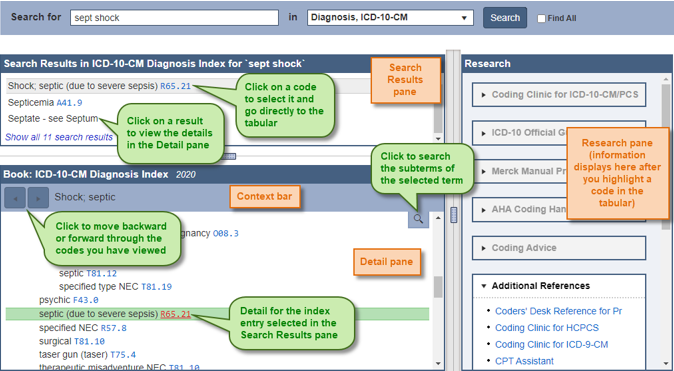

The display includes the following features:
- Backward and forward navigation – Click to move back and to move forward through the codes you have viewed.
- Subterm search – A subterm search searches through the subterms of a selected term. This is useful when there is a long list of subterms, you can use the subterm search rather than scrolling through the long list to find the subterm for which you are searching.
- Shortcuts – Keyboard shortcuts are available for some actions in the encoder. For example, you can press Ctrl + ↑ and Ctrl + ↓ to move the cursor though the fields and panes. For a complete listing for keyboard shortcuts, see Keyboard Shortcuts on page 23.
- Find All search – A Find All search looks for terms outside of the structure of the index. The search results display all occurrences of the terms in the code book that is searched. See Searching for All Occurrences of a Term on page 22 for more information.
- Table search – You can search the Hypertension table, Neoplasm table, and the Table of Drugs and Chemicals.
- Hypertension table – In the ICD-9-CM diagnosis code book, this table lists diseases due to hypertension.
- Neoplasm table – In the ICD-9-CM and ICD-10-CM diagnosis code books, this table lists anatomical sites alphabetically, with columns to indicate the code for each behavior type, such as primary, secondary, benign, etc.
- Table of Drugs and Chemicals – In the ICD-9-CM and ICD-10-CM diagnosis code books, this table contains a classification of drugs and chemicals to identify poisoning states and external causes of adverse effects.
- See and See Also cross-references – The indexes include See and See also instructions which are cross-references to other areas of the index.
- Synonym search – Synonyms are acronyms, abbreviations and shortcuts you can use to search the alphabetic index. Performing a search using a Synonym is the same as a search using terms. The Synonyms list contains a list of Synonyms that can be used in a search.
- Custom index lines – Custom index lines are alphabetic index entries that have been added to the official ICD-9-CM indexes. These entries are noted with the symbol before the alphabetic index line.
Note
The source of the custom index line is noted in parentheses.
- E code search – The E code index (external cause of injury index) functions the same as the other indexes. Like the other indexes, you access it from the code book drop-down list. Within the structure of ICD-9-CM and ICD-10-CM, there are many E codes with subterms of one or two words, such as by, with, due to, and from. You do not need to enter such terms in the encoder search.
Note
ICD-10-CM external cause of morbidity codes do not begin with an E. They begin with the characters V, W, and X.
- - icon – In the ICD-10-CM index, a - follows codes that require additional characters. To view the additional characters, click on the code to proceed to the tabular.


About the Tabulars
The tabulars include all instructional notes, such as Includes, Excludes, Chapter, and Category notes. Codes included in the instructional notes, as well as in the tabular, are links that can be accessed.
The tabulars include the following features:
- Instructional notes – If a code has an instructional note, the symbol appears to the left of the code when the code is highlighted. Instructional notes contain Includes, Excludes, and Notes from the chapter, section, and category levels. To view the note, click on the symbol
- and – Click to move backward and forward through the codes you have viewed or move back to the index.
- Crosswalk – Crosswalk is a mapping between ICD-9-CM procedure codes and associated CPT codes. Using crosswalk you can gather ICD-9-CM and CPT codes simultaneously. For information on using crosswalk, see Using Crosswalk on page 31.
- Anesthesia Crosswalk – Anesthesia Crosswalk is a mapping between CPT surgical codes and CPT anesthesia codes. Using anesthesia crosswalk you can gather CPT surgical and anesthesia codes simultaneously. For more information on using anesthesia, see Using Anesthesia Crosswalk on page 32.
- Symbols – Symbols are used in the tabular to provide additional information. For most symbols, when you rest your mouse pointer on it, a description of the symbol appears.
- - In the ICD-10-CM tabulars, click following a code to expand the seventh character list, or click following a code to collapse the seventh character list.
- HCCs – Category numbers (example, ) for Hierarchical Condition Categories (HCCs) are shown by ICD-10-CM codes that are part of the HCC model. HCCs are used to risk-adjust population data for Medicare Managed Care programs. CMS is using two versions of the HCC model, versions 24 and 28. Both versions are in use and appear in the tabular until version 28 is fully implemented in 2026. You can view HCC details and the HCC version by resting your mouse pointer on a category number.
- Shortcuts – Keyboard shortcuts are available for some actions in the code books. For example:
- In the ICD-10-CM tabular, you can press the right → key to expand the seventh character list and the ← key to collapse the list.
- Press Ctrl + ↓ to move forwards or press Ctrl + ↑ to move backward through the panes and resizers, and place the focus as appropriate.
- Research pane – The Research pane displays information about the selected code.
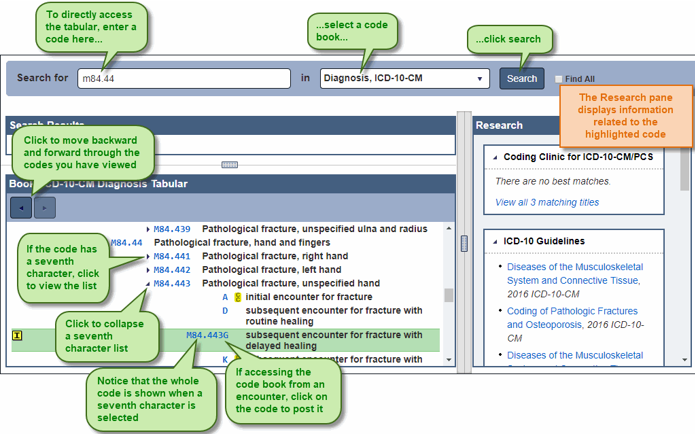

Keyboard Shortcuts
The following shortcuts can be used in the CodeBooks control:
| Shortcut | Location | Description |
|---|
| ← → | ICD-10-CM Tabulars | With the focus on a code with a seventh character, press to expand or collapse the seventh character list. |
| ← → | ICD-10-PCS index | Press to move between term and code in a see or see also note. Press Enter to then move to the new index location or the table. |
| ← → | ICD-10-PCS table | Press to move between the columns in the table. |
| ← → | ICD-9-CM and ICD-10-CM indexes | With the focus on a row in the Neoplasm table, Hypertension table, or Table of Drugs and Chemicals; press to move through the columns. |
| ← → | Vertical splitter bar | With the focus on the splitter bar, press to resize the panes. Press Enter to confirm the new size. |
| ↑ ↓ | Indexes and tabulars | Press to move backwards or forwards through the panes and resizers. |
| ↑ ↓ | ICD-10-PCS table | Press to move up and down through the items in a column. |
| ↑ ↓ | Horizontal splitter bar | With the focus on the splitter bar, press to resize the panes. Press Enter to confirm the new size. |
| Ctrl + ↑, Ctrl + ↓ | Indexes and tabulars | Press to move backwards or forwards through the panes and resizers. |
| F | ICD-9 or ICD-10 index | Press to start a subterm search. |
| Esc | Subterm search field | Press to hide the subterm search field. |
| Backspace | ICD-10-PCS table | Press to move back a column. |
| Designated Key | ICD-10-PCS table | Press the letter or number key for the item in the highlighted column that you would like to select. |
| Enter | Indexes and tabulars | With the focus in the search bar, press to perform a search. |
| Enter | Tabulars | Press to post the highlighted code. |
| Enter | ICD-10-PCS table | Press to select the highlighted item in a column and move to the next column, or to post a completed code. |
| Enter | Splitter bar | When resizing a pane using keyboard shortcuts, press to confirm the change. |
Searching for an ICD-10-CM Code
- Enter a term, terms, or code in the Search For field
Tip
The terms can be shortened to the first 3 or 4 letters and can be entered in any order. For a code, enter as little as the first 3 digits.
There are many E codes with subterms of 1 or 2 words (by, with, due, to, from, etc.). These terms do not need to be entered in the search.
- Choose the Diagnosis, ICD-10-CM or External Cause, ICD-10-CM code book from the code book list.
- Click Search to view the search results. The Search Results pane displays the results. Several results may be shown due to the search terms being found in multiple places in the alphabetic index.
Note
If you searched by a code you are taken directly to the tabular
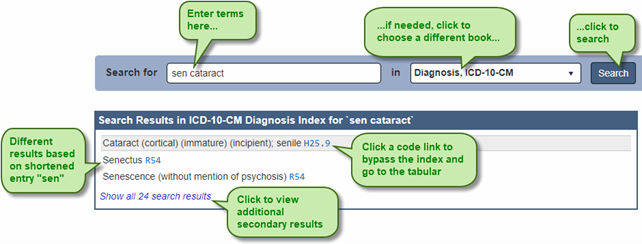

- If there are additional secondary results that you want to view, click the Show all x search results link
Tip
The first results are the best results based upon the search terms uses. The secondary results are particularly helpful when you are unsure of the terms to enter for a disease.
- To view the detail for a term in the Search Results pane, click on it


- If a cross-reference (see or see also note) is listed and you want to view it, click the link to view the related term.
Tip
For conditions that involve more than one code, the additional codes are listed in brackets. To view the first code in the tabular, press Enter. Then press Enter again to view the second code in the tabular. If there is a third code, press Enter again to view the third code. When you press Enter one more time, the codes are posted.


- To select a code and open the tabular, click on the code in either the Search Results or the Detail pane.
Note
ICD-10-CM external cause of morbidity codes do not begin with an E. They begin with the characters V,W, or X.
- In the tabular, check any instructional notes. To do so, click on the symbol to the left of the code to open the instructional notes.


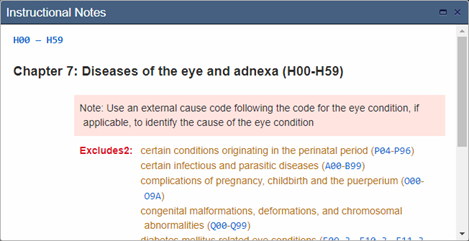

Perform any needed research.
The code may require a seventh character, a character that provides additional information about the diagnosis and the encounter. If this is the case, a appears to the left of the code. Do the following to select the seventh character for the code:
- Click to expand the list of seventh characters.
Tip
To expand a list of 7th characters, click the arrow to the left of the code, or when the code for which you want to view the 7th characters is highlighted, press the right arrow key.
Note
Some codes that require a 7th character do not contain six characters. When that is the case, an X fills and missing characters.
- Locate the applicable 7th character for the code
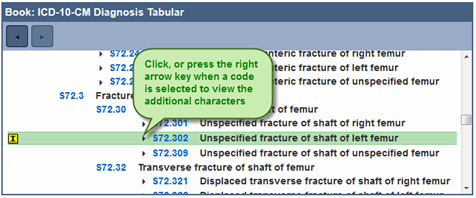

If the code book was accessed from an encounter, click on a code to post it
Tip
When the code is highlighted, you can press Enter to post the code.
Searching for an ICD-10-PCS Procedure Code
- Enter the term, terms, or code in the Search for field.
Tip
Multiple terms can be entered in the Search for field. Terms can be shortened and entered in any order. For a code, you can enter as little as the first digit of the code.
- Choose the Procedure, ICD-10-PCS code book from the code book list.
Tip
With the focus on the code book list, you can press the down arrow to scroll through the list of books.
- Click Search or press Enter to view the search results. The Search Results pane displays the results. Several results may be shown due to the search terms being found in multiple places in the alphabetic index.
Note
If you search by a code, you are taken directly to the ICD-10-PCS table. If your search could be the start of either a code or a term, search results appear for both the partial code match and the index entries.


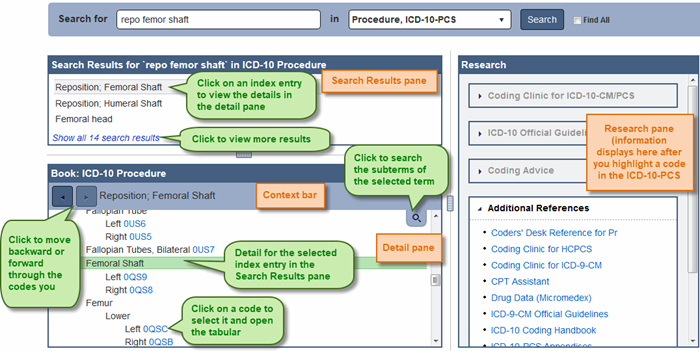

- If there are additional secondary results that you want to view, click the Show all x search results link.
Tip
The first results are the best results based upon the search terms used. The secondary results are particularly helpful when you are unsure of the terms to enter.
- To view the detail for an index entry in the Search Results pane, click on it.
- If a cross-reference (see or see also note) is listed and you want to view it, click the link to view the related term.
- To select a code and open the ICD-10-PCS table, click on the code in either the Search Results or the Detail pane.
- Perform any needed research.
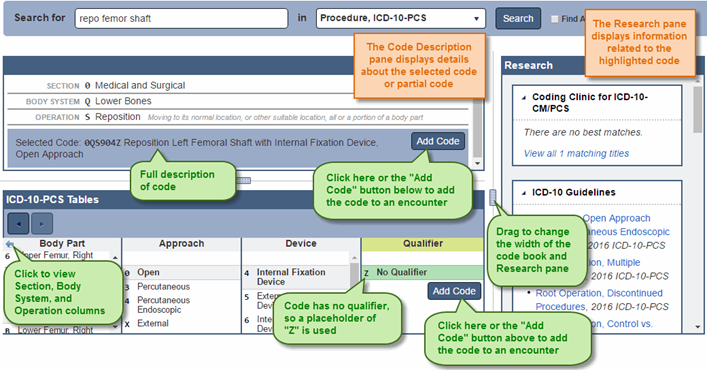

- In the Body Part column of the ICD-10-PCS table, verify that the correct body part on which the procedure was performed is selected. If needed, click on a different body part.
Tip
Notice that the beginning of the code, the part selected in the index, appears in the Search Results pane.
- In the Approach column, the procedure approaches for the selected body part, if any, are now listed.
Note
The column headings may be different than the ones listed in this example, depending upon the procedure.
- Choose an approach.
- In the Device column, the devices for the selected approach, if any, are now listed.
Tip
To make changes to the Section, Body System, or Operation dor the code click the back arrow in the Body Part column heading or with the Body Part column selected, press the left arrow key. To move back to the last four columns in the table, click on the forward arrow in the Body Part column heading or with the Body Part column selected, press the right arrow key.
Choose a device.
- In the Qualifier column, the qualifiers for the procedure, if any, are now listed.
Choose a qualifier.
When you are finished selecting the aspects of the code, press Enter, or click Add Code in the Code Description pane or the 7th character column to post the code.
Searching for a CPT or HCPCS Code
The CPT and HCPCS index search uses both the index and tabular books simultaneously and displays tabular results based upon that search.
- Enter terms or a code in the Search for field
Tip
The terms can be shortened to the first 3 or 4 letters and can be entered in any order. For a code, you can enter as little as the first two digits of the code.
- Choose the CPT Tabular or HCPCS Tabular from the list of code books.
Tip
You can tab to the code book field and press C to select the CPT tabular or H to select the HCPCS tabular.
- If you want anesthesia codes to be included in the search results, click the Include Anesthesia Codes check box.
- Click Search to view the search results in the Search Results pane. The best matches are listed first.
Tip
The first results are the best results based upon the search terms used. The secondary results are particularly helpful when you are unsure of the terms to enter for a disease.
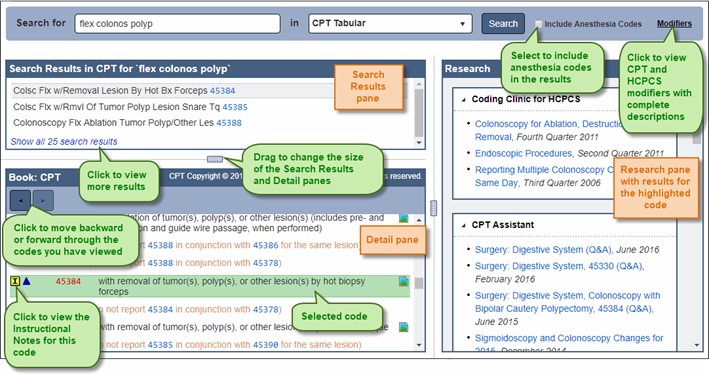

- To view the CPT and HCPCS modifiers with long descriptions, click the Modifiers link.


- Check any instructional notes. To do so, click on the symbol to the left of the code.


- Perform any needed research. If there are additional crosswalk results and you want to view them:
- Click the View all crosswalk results link in the Crosswalk section of the Research pane to view all crosswalk results.
- To view a code in the tabular, click on it.

 - If you accessed the code book from an encounter, press Enter to post both the CPT code and the ICD-9-CM procedure code.
- If you accessed the code book from an encounter, press Enter to post both the CPT code and the ICD-9-CM procedure code.
- If you accessed the code book from an encounter, click on a code to post it.
Tip
When the code you want to add is highlighted, you can press Enter to post it.
Searching the Neoplasm, Drug, or Hypertension Table
- To access a table, do one of the following:
- To access the Neoplasm table, enter the term Neoplasm or a shortened version of neoplasm, such as Neop, and the site of the neoplasm in the Search for field.
- To access the Table of Drugs and Chemicals, enter the term Table and the drug name or partial name in the Search for field.
- To access the Hypertension table, enter the term hypertension or htn and a term in the Search for field.
Note
The Hypertension table is only in the ICD-9-CM Diagnosis code book
- Select Diagnosis, ICD-9-CM or Diagnosis, ICD-10-CM from the code book list.
- Click Search to view the search results.
- If there are additional secondary results that you want to view, click the Show all x search results link.
Tip
The first results are the best results based upon the search terms used. The secondary results are particularly helpful when you are unsure of the terms to enter.
- To view the detail for a term in the Search Results pane, click on it.
Tip
If you scroll through a table, the column headers follow so you always see the description of the columns.
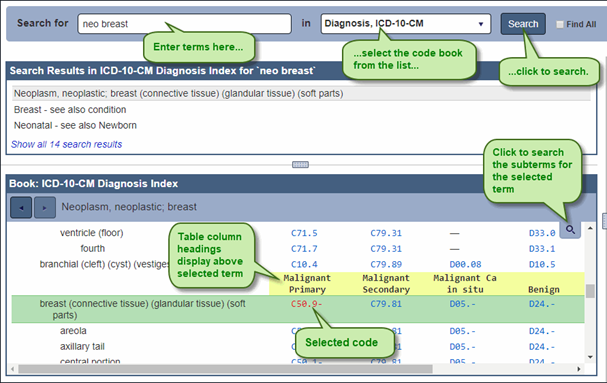

- To move through the columns, press → or ← key. The selected code is red.
- If a cross-reference (see or see also note) is listed and you want to view it, click the link to view the related term.
Tip
In the ICD-9-CM Table of Drugs and Chemicals, when appropriate, the poisoning code is highlighted in red as well as the external cause code. This indicates that both of the codes are required to fully code the condition. When you press Enter both of these codes are posted. Note that this does not apply to the ICD-10-CM Table of Drugs and Chemicals; only a single code is needed to fully identify both the agent and the circumstances.


- To select a code and open the tabular, click on the code in either the Search Results or the detail pane.
- In the tabular, check any instructional notes. To do so, click on the symbol to the left of the code to open the instructional notes.


- Perform any needed research.
- If you accessed the code book from an encounter, click on a code to post it.
Searching for All Occurrences of a Term
The Find All search provides the ability to search for terms outside of the structure of the ICD-9-CM or ICD-10-CM /PCS index. The search results display all occurrences of the terms in the code book that is searched, no matter where in the code book the terms are found.
- Enter the term or terms in the Search for field.
Tip
The term can be shortened to the first three or four letters and can be entered in any order.
- If you need to change code books, select the book from the list.
- Click the Find All check box to select it.
- Click Search to view the search results. In the Search Results pane, all index entries containing the terms are shown.
Note
Find All remains active until you remove the check from the Find All check box.
- If there are additional secondary results that you want to view, click the Show all x search results link.
Tip
The first results are the best results based upon the search terms used. The secondary results are particularly helpful when you are unsure of the terms to enter.
- Proceed with your search as usual. See the steps for the specific code book you are searching for additional information.
Searching for a Subterm
The Subterm search provides the ability to search for the subterm of a selected term in an ICD-9-CM and ICD-10-CM/PCS index (this type of search does not apply to the CPT or HCPCS code books). The subterm search is particularly useful when a term has many subterms.
- Click the icon or press the F key.


- Enter the subterm in the Search subterms field and press Enter or click the up or down arrow.
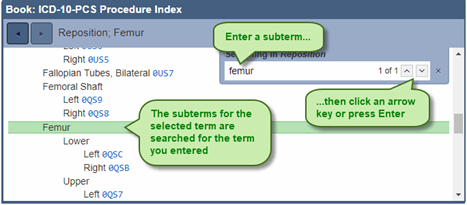

- To continue searching for the subterm, press Enter or click the up or down arrow again.
- Click the x to close the subterm search.
- Proceed with your search as usual. See the steps for the specific code book you are searching for additional information.
Codebook Symbols
The following symbols appear in the CodeBooks control. For most symbols, when you rest your mouse pointer on the symbol, a description appears.
| Icon | Location | Description |
|---|

 | All tabulars | Click to access Instructional Note |

 | All tabulars | New code |

 | All tabulars | Modified code |

 | All tabulars | Modified note |

 | ICD Diagnosis tabulars | Major Complication / Comorbid Condition |

 | ICD Diagnosis tabulars | Complication / Comorbid Condition |

 | ICD Diagnosis tabulars | Major Complication / Comorbid Condition, Patient Discharged Alive |

 | ICD-10 Diagnosis tabular | Hierarchical Condition Category (HCC) |

 | ICD-10-CM tabular | Access the seventh character of a code (click the to expand or collapse the list) |

 | CPT | Click to view the image |

 | CPT | Code appearing out of numerical order |

 | CPT | Modifier 51 exempt |

 | CPT | Conscious sedation |

 | CPT | Add-on code |

 | CPT | Pending FDA Approval |

 | CPT | Telemedicine Service |

 | CPT | Proprietary Laboratory Analyses (PLA) code |

 | CPT | Satisfies Category 1 Criteria |

 | CPT | Code may be used for reporting audio-only services when appended with modifier 93 |

 | ICD indexes | Custom TruCode content (view the tooltip for details about the type of custom content) |

 | ICD-10-CM index | Code has a seventh character |

 | Crosswalk | Best match (most common match or major topic) |

 | Crosswalk | Other match (less common match or minor topic) |
Research
The Research control consists of the following panes:
- DRG Analysis – This pane displays alternate DRGs based upon the current DRG, codes present in the encounter, and the patient status.
- ICD-10 –This pane displays equivalent ICD-10-CM / PCS codes for a selected ICD-9-CM code.
- Research –This pane contains reference and coding information applicable to a selected code.
- Edits – This pane displays edits for an encounter.
Using the DRG Analysis Pane
This tool suggests alternate DRGs based upon the current DRG, codes present in the encounter, and the patient status. The list of possible alternate DRGs includes the requirements that would need to be met and the applicable codes to add to the encounter if the documentation supports these changes.
- Code the encounter.
- Click on the DRG Analysis tab.
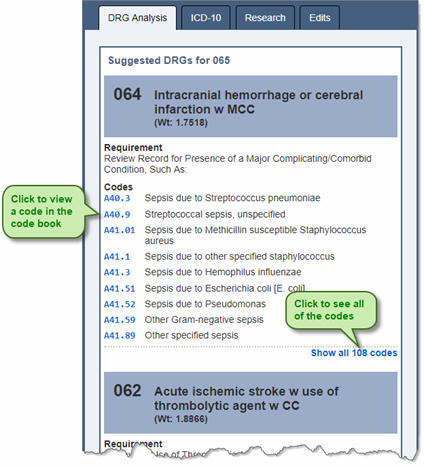

- To show all of the applicable codes for the suggested DRG and requirements, click the Show all codes… link at the end of the Codes list.
- If you want to view more information about a code, click on the code to view it in the code book.
Using the ICD-10 Pane
The ICD-10 pane displays equivalent ICD-10-CM / PCS codes for a selected ICD-9-CM code, and equivalent ICD-9-CM codes for a selected ICD-10-CM / PCS code. ICD-10-CM / PCS will replace ICD-9-CM under CMS mandate; to help you familiarize yourself with the new ICD-10 codes, you can view code equivalents in the ICD-10 pane. Because of the differences in the ICD-9 and ICD-10 classifications, there are only a few instances where a one-to-one code match occurs. There are also times when there is no code equivalent, and sometimes there is a choice of one of many codes, or one of many of several groups of codes. Read the instructions provided in each message in the ICD-10 pane for detailed information.
- Click on a code in an encounter to select it.
- Click on the ICD-10 tab to display equivalent codes for the selected code.
Example of ICD-10-CM / PCS equivalents for a selected ICD-9-CM code:
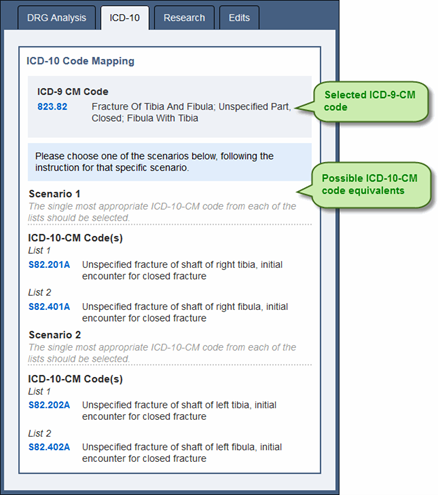

Using the Research Pane
The Research pane contains information applicable to the selected code. The following information is shown in the Research pane as applicable:
- AHA Coding Handbook – AHA ICD-10-CM and ICD-10-PCS Coding Handbook is a guide to ICD-10-CM and ICD-10-PCS coding.
- Anesthesia Crosswalk – Anesthesia Crosswalk is a mapping between surgical CPT and HCPCS codes and anesthesia CPT and HCPCS codes. Using anesthesia crosswalk you can gather surgical and anesthesia CPT or HCPCS codes simultaneously.
- Coders’ Desk Reference – Optum Coders’ Desk Reference for Procedures provides descriptions of CPT codes.
- Coding Advice – Coding Advice is additional coding instructions, authored by TruCode and based on official sources.
- Coding Clinic – American Hospital Association (AHA) Coding Clinic for ICD-9-CM, Coding Clinic for HCPCS, and Coding Clinic for ICD-10-CM / PCS provide coding advice. The articles related to the selected code appear in reverse chronological order.
- CPT Assistant® – American Medical Association (AMA) CPT Assistant® provides CPT and HCPCS coding guidance. The articles related to the selected code appear in reverse chronological order.
- Crosswalk – Crosswalk is a mapping between ICD-9-CM procedure codes and associated CPT codes. Using crosswalk you can gather ICD-9-CM and CPT codes simultaneously.
- Interventional Radiology – MedLearn Interventional Radiology provides CPT and HCPCS procedure coding information. The articles related to the selected CPT or HCPCS code are shown. The articles related to the selected code appear in reverse chronological order.
- Official Guidelines – Guidelines for ICD-9-CM and ICD-10-CM coding approved by the cooperating parties: the American Hospital Association, the American Health Information Management Association, the Centers for Medicare and Medicaid Services, and the National Center for Health Statistics. The articles related to the selected code appear in reverse chronological order.
- Merck Manual Professional – Merck Manual Professional provides detailed information to enhance ICD-10-CM and ICD-9-CM coding, including descriptions, etiologies, classifications, signs and symptoms, diagnoses, prognoses, and treatment information. The material is presented in articles, tables, videos, audio, 3D models, calculators, images, lab tests, and sidebars.
Note
Merck Manual Professional opens in the Merck manuals web site.
- Additional References – Other references, such as Dorland Medical Dictionary and Micromedex Drug Data. Also, references that do not pertain to the selected code appear here. For example, when an ICD-10-CM code is selected, Coders’ Desk Reference, Coding Clinic for HCPCS, Coding Clinic for ICD-9-CM, CPT Assistant, ICD-9-CM Official Guidelines, and Interventional Radiology appear in the additional references since they do not pertain to an ICD-10-CM code.
Using the References in the Research Pane
- In the Research pane, review any reference information that appears for a code.
- To read an article, click on the title to open the References control.
Note
Merck Manual Professional opens in the Merck manuals web site.
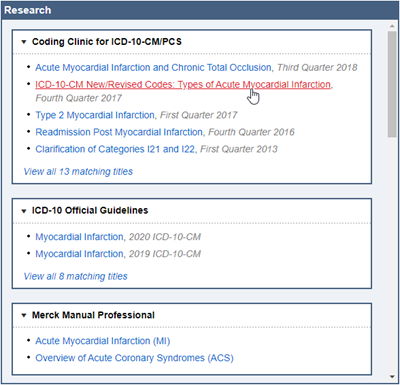

- To view a reference that contains no articles for the selected code (greyed out reference), expand the reference and click the link to open the References control.
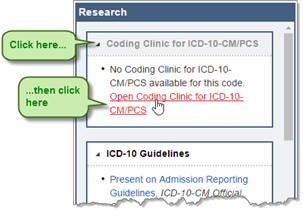

- To view other reference information, click on the title of the reference in the Additional References section to open the References control and access the reference.


Note
The ICD-10-PCS Definitions, Keys and Tables and ICD-10-PCS Reference Manual are PDF files and open in a browser window rather than in the References control. The MS-DRG Definitions Manuals, Merck Manual Professional, and Reference Library Archive link to websites and also open in your browser.
Using Coding Advice
- In the Research pane, review the advice in the Coding Advice section. This advice pertains to the selected code in the code book or an encounter.
- If the advice includes links to codes, click on the code to view it in the code book.


- From the code book, press Enter to post the code.
Using Crosswalk
- With a CPT code or an ICD-9-CM procedure code highlighted in the code book or in an encounter, notice that any potential code matches appear in the Crosswalk section of the Research pane.
Crosswalk for an ICD-9-CM procedure code:
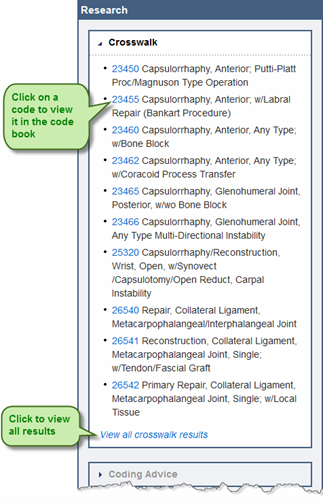

- Click on a code in the Crosswalk section of the Research pane to view that code in the tabular. If you accessed the code book from an encounter, press Enter to post both the CPT code and the
ICD-9-CM procedure code.
- If there are additional crosswalk results and you want to view them, click the View all crosswalk results link in the Crosswalk section of the Research pane to view all of the crosswalk results.
Using Anesthesia Crosswalk
If a surgical CPT code has potential corresponding anesthesia CPT codes, the codes appear in the Anesthesia Crosswalk section of the Research pane.
- With a CPT code highlighted in the code book or in an encounter, notice that any potential anesthesia CPT code matches appear in the Anesthesia Crosswalk section of the Research pane.
- Click on a code in the Anesthesia Crosswalk section of the Research pane to view that code in the code book. If you accessed the encoder from an encounter, press Enter to post both the surgical CPT code and the anesthesia CPT code.
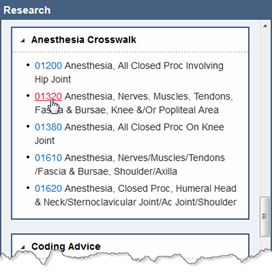

Using the Edits Pane
Edits for an encounter are shown on the Edits pane and are separated into the following categories:
Medicare code edits – These edits are developed by CMS for inpatient encounters.
Outpatient code edits – These edits are developed by CMS for outpatient encounters. Either the Outpatient Prospective Payment System (OPPS) or non-OPPS version of the Outpatient Code Editor (OCE) is used to generate these edits. By default the OPPS edits display here.
TruCode edits – These edits include proprietary edits developed by TruCode as well as edits provided by regulatory and other agencies.
Medical Necessity Edits – These are LCD / NCD (Local Coverage Determination and National Coverage Determination) edits.
RAC Alert! – Information appears here to alert you that a CMS approved audit issue, in your facility’s recovery audit contractor (RAC) region, has been identified on the patient record. The RAC information shown is based on the facility MPN. The following types of CMS approved RAC targets are included:
- DRG validation
- HCPCS code vulnerability
- Inpatient medical necessity
As the RACs expand their targets, the RAC targets will be updated accordingly.
Validation – These are edits related to the general validity of field values in the encounter. This includes edits for invalid and out-of-range numbers and dates.
The following information is included for each edit:
- Edit message – A brief description of the edit.
- Source – For TruCode edits, the official source of the edit is listed, such as Coding Clinic, the CPT book, etc.
- Details link – When clicked, additional information about the edit is shown.
- Click on the Edits tab to view the edits for the encounter.
- To view edit details, click the details link.
- To view a code in the code book, click a code link in an edit message.
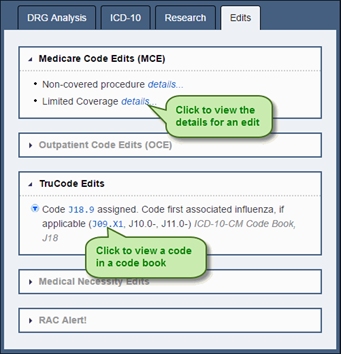

If the encounter has Medical Necessity Edits, you can also view the policy by clicking the policy link.


Research Keyboard Shortcuts and Symbols
The following shortcuts can be used in the Research control:
| Shortcut | Location | Description |
|---|
| ← → | Tabs of Research control | When the focus is on the tabs, press to switch between the tabs (DRG Analysis, ICD-10, Research, and Edits). |
| Enter | Research pane | Press to collapse or expand a section. |
| ↑ ↓ | Research pane | Press to move between sections. |
The following symbols appear in the Research control:
| Shortcut | Location | Description |
|---|

 | Edits | Recovery audit contractor (RAC) region alert |

 | Coding Advice, Edits | Custom coding advice or custom edit |
References
The References control contains the following references and features:
| Reference | Description |
|---|
| AHA Coding Handbook | AHA ICD-10-CM and ICD-10-PCS Coding Handbook is a guide to ICD-10-CM and ICD-10-PCS coding. |
| Coders’ Desk Reference | Optum Coders’ Desk Reference for Procedures provides descriptions of CPT codes. |
| Coding Clinic | American Hospital Association (AHA) Coding Clinic for ICD-9-CM, Coding Clinic for HCPCS, and Coding Clinic for ICD-10-CM / PCS provide coding advice. |
| CPT Assistant® | AMA CPT Assistant® provides CPT and HCPCS coding guidance. |
| Drug Data (Micromedex) | Micromedex Drug Database contains brand name and generic drug information. |
| Official Guidelines | Guidelines for ICD-9-CM and ICD-10 coding approved by the cooperating parties: the American Hospital Association, the American Health Information Management Association, the Centers for Medicare and Medicaid Services, and the National Center for Health Statistics. |
| Interventional Radiology | MedLearn Interventional Radiology provides CPT and HCPCS procedure coding information. |
| Medical Dictionary (Dorland) | Dorland Illustrated Medical Dictionary contains definitions of medical terms and illustrations. |
| Search for field | To perform a new search, enter search terms or a code in this field. |
| References list | Choose the reference you want to search from this list. |
| Search | When you are ready to perform a search, click Search. |
| Browse reference library list | Click to choose a reference to browse in its entirety from the list. |
| Browse Issue link | Click this link to display the complete list of articles in the same issue as the currently-shown article. |
| Search Results pane | Lists the matches for your search. Click on a match to view it in the article pane. |

 | Best match results are identified with a green bullet point. A best match result is an article for which the searched-for code or term is a major topic of the article. |

 | Other results are identified with a black bullet point. These results are similar to the results of a Find All search; the code or term is found in the article, but is not the major topic of the article. |
| Article pane | Pane that displays the selected article. |
| ← and → | Click to move backward and forward through the articles you have viewed. |

 
 | Click to view the next or previous term or code in the article that matches the search criteria. These buttons are active when the Highlight matched terms check box is selected. |
| Highlight matched terms check box | Remove the check from this box to view the article without highlighting the terms or code that match the search criteria. Check this box to highlight the terms or code that match the search criteria and to use the Previous Term and Next Term buttons. |
| Notes pane | Some articles include a Notes pane below the article which contains information about superseded advice, corrected advice, and code updates. |
Note
The last used reference is remembered. The next time the Reference control is visited the most recently used reference is automatically selected in the references list.
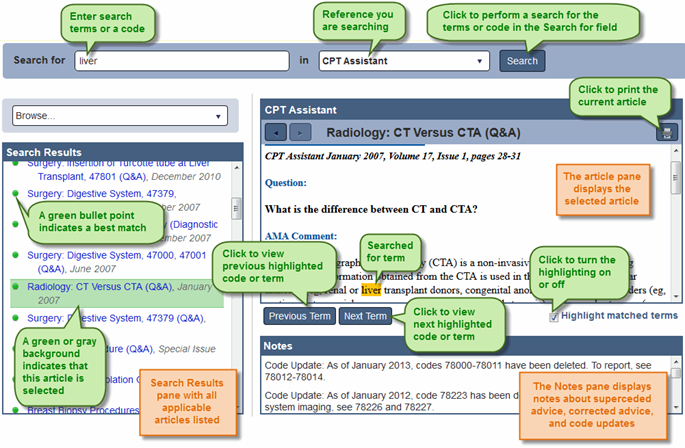

Searching the References
- From the References control, enter search terms or a code in the Search for field using the guidelines below:
- For AHA Coding Handbook, Coding Clinic, CPT Assistant, Interventional Radiology, or Official Guidelines, enter terms or a code.
- For the Drug Data reference, enter terms, drug name (generic or brand name), or an indication.
- For the Coders’ Desk Reference, enter a CPT code.
- For the Medical Dictionary, enter terms.
Note
You can also access the References control from the Research control. To do so, click on an article title in the Research control, or click on a reference in the Additional References list.
- Choose a reference from the list.


- Then click Search. The search results appear with the article for the first result displaying in the Article pane.
Note
If you opened the References control by clicking on an article title in the Research pane, the article you selected displays in the Article pane; you do not need to search for it.


- To view a different article, click on the article in the Search Results pane to display it in the Article pane.
- In Drug Data, do the following to view a drug listed in the indications:
- Click the next to an indication to expand it.
- Then click on a drug name to view that drug.
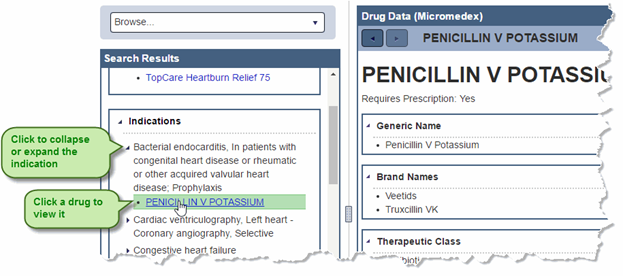

- In Interventional Radiology, click on an image in an article to view it larger.


- In the AHA Coding Handbook, you can show or hide answers to exercises:
- To show a specific answer in the exercise, rest your moue pointer on the ? icon for the question.
- To show all answers for the exercise, click show all.
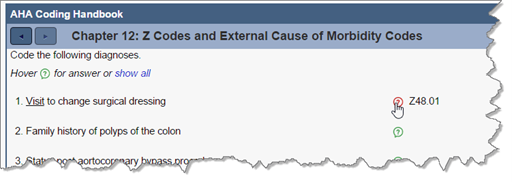

When viewing an article in the AHA Coding Handbook, Coding Clinic, CPT Assistant, Official Guidelines, or Interventional Radiology reference, you can browse the other articles in the issue:
- Click Browse Issue to display the articles in the issue in the Search Results pane.
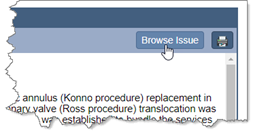

- Click on an article title to view it or choose a different year and issue in the Search Results pane.
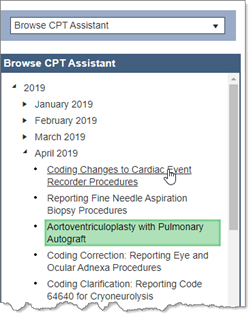

Note
Browsing an issue is only available when you have searched for a code or term before selecting an article. It is not available when you are already browsing.
- To browse the AHA Coding Handbook, Coding Clinic, CPT Assistant, Official Guidelines, or Interventional Radiology reference:
- Click Browse and choose a reference to browse from the list.
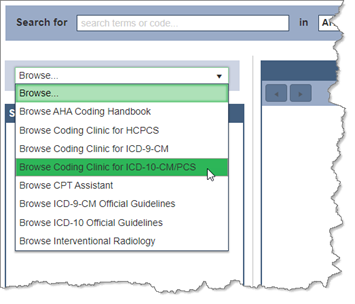

- In the Search Results pane, click on the year for the issue you want to browse.
- Then click on the issue you want to browse.
- Click on an article title to view it.
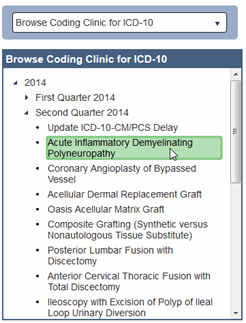

Reference Keyboard Shortcuts and Symbols
The following shortcuts can be used in the References control:
| Shortcut | Location | Description |
|---|
| ← → | Splitter bar | With the focus on a splitter bar, changes the size of a pane. Press Enter to confirm the size change. |
| ← → | Search Results pane | Expands or collapse Drug Data indications and issues you are browsing. |
| ↑ ↓ | Search Results pane | Move up or down through the list of entries. Press Enter to view an entry in the Article pane. |
| ↑ ↓ | Article pane | Move up or down through the article. |
| Enter | Search Results pane | When the focus is on an article title in the Search Results pan, press to view the entry in the Article pane. |
| Enter | Splitter bar | When resizing a pane using keyboard shortcuts, press to confirm the change. |
| Ctrl + ↑ | References control | Press to move backwards or forwards through the panes and resizers, and place the focus as appropriate. |
| Ctrl + ↓ | References control | Press to move backwards or forwards through the panes and resizers, and place the focus as appropriate. |
The following symbols appear in the References control:
| Symbol | Location | Description |
|---|

 | Search Results pane | Best match results are identified with a green bullet point. A best match result is an article for which the searched-for code or term is a major topic of the article. |

 | Search Results pane | Other results are identified with a black bullet point. These results are similar to the results of a find all search; the code or term is found in the article, but is not the major topic of the article. |

 | Article pane | Rest your mouse pointer on this icon to view an exercise answer. |
































































